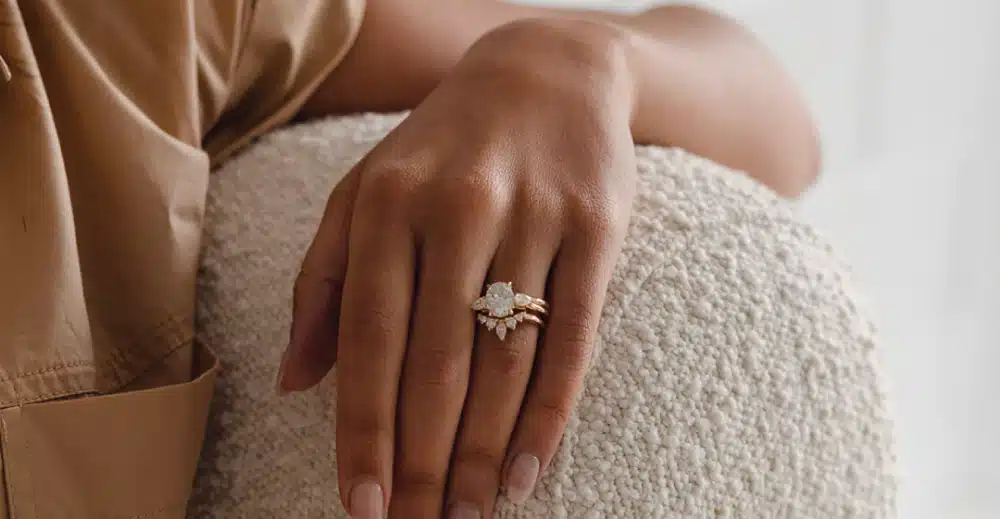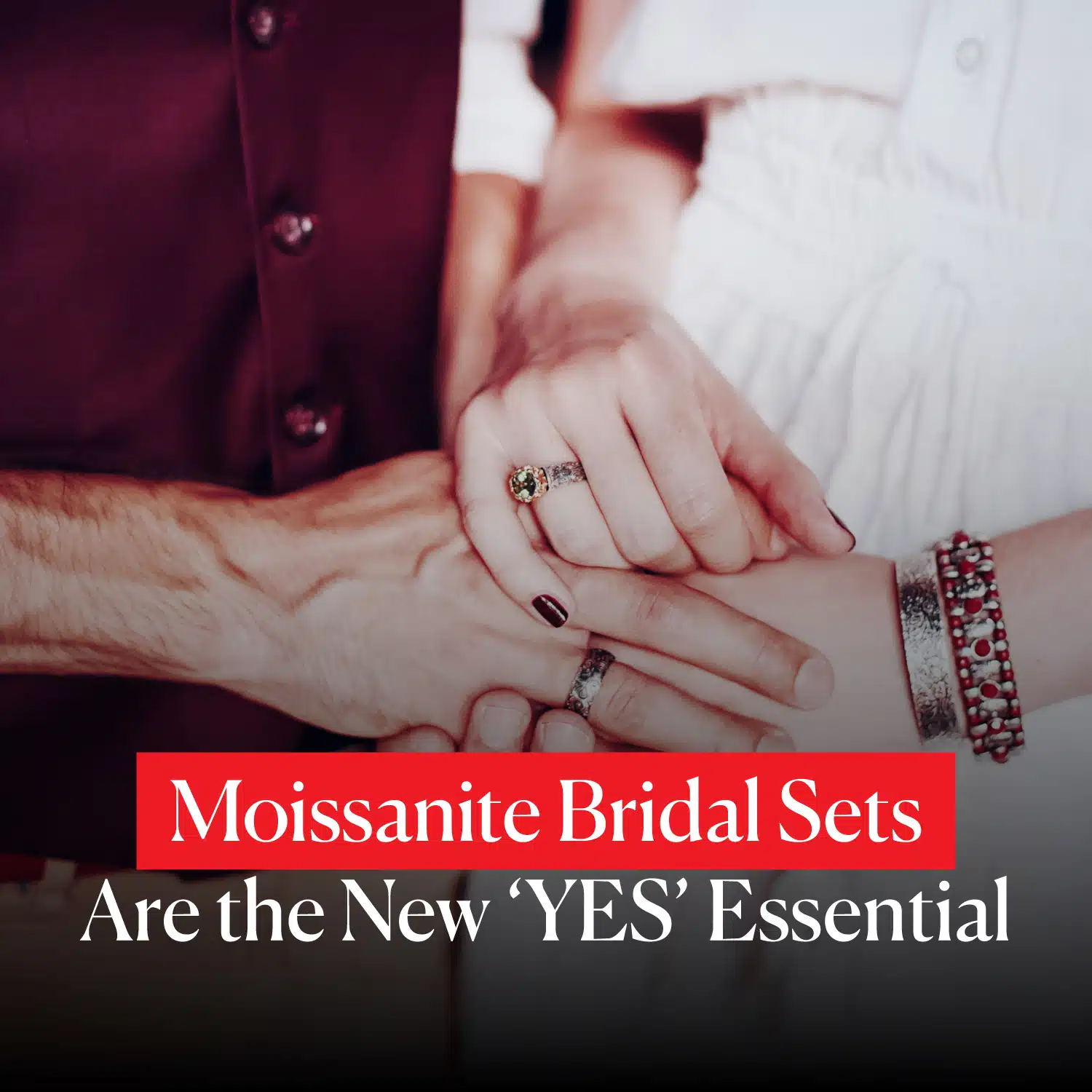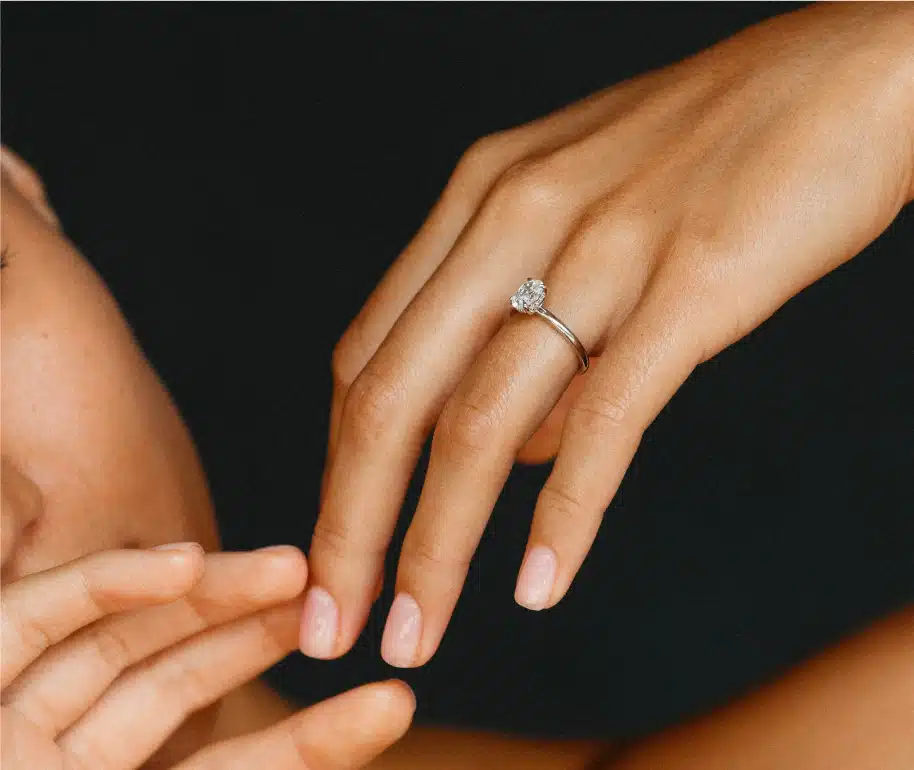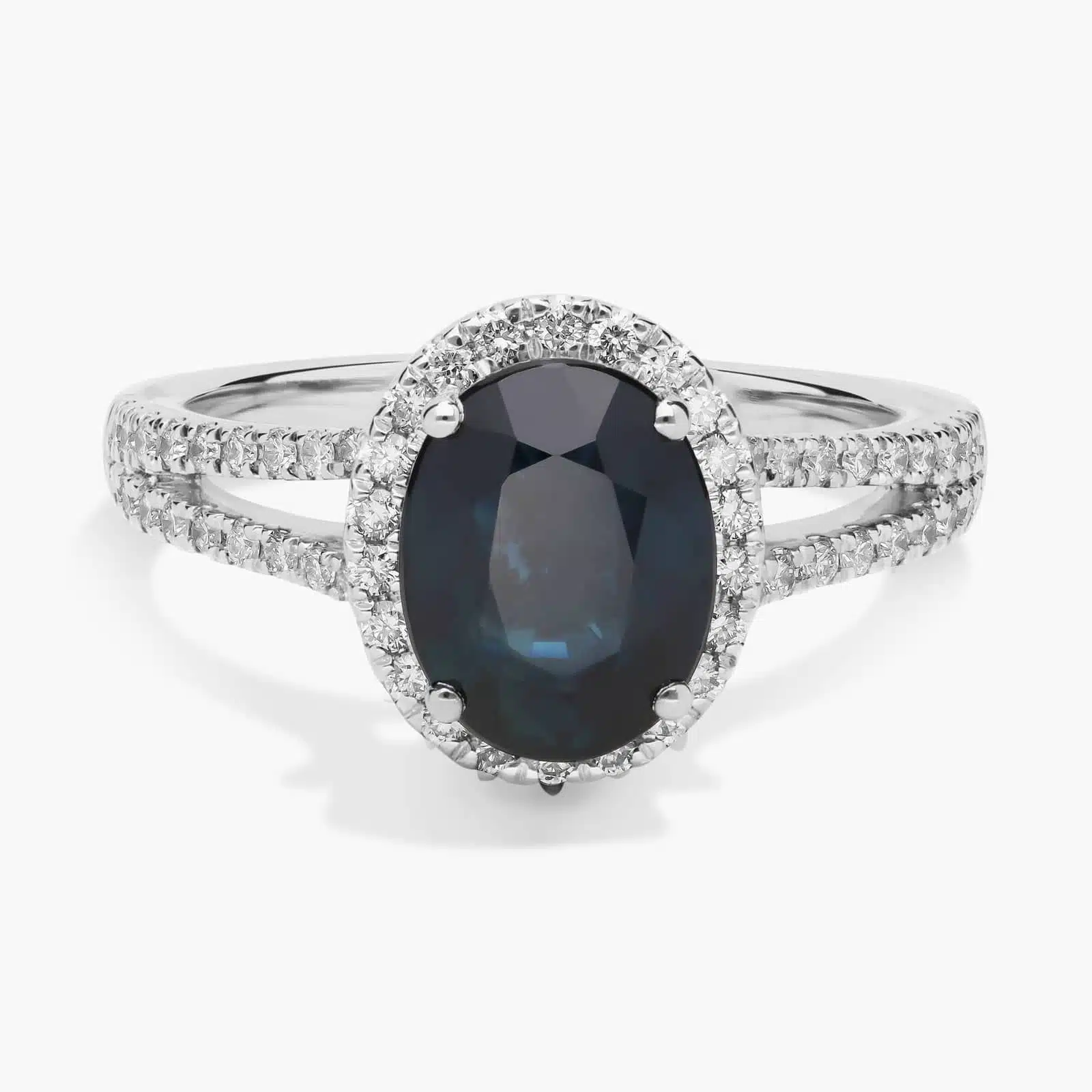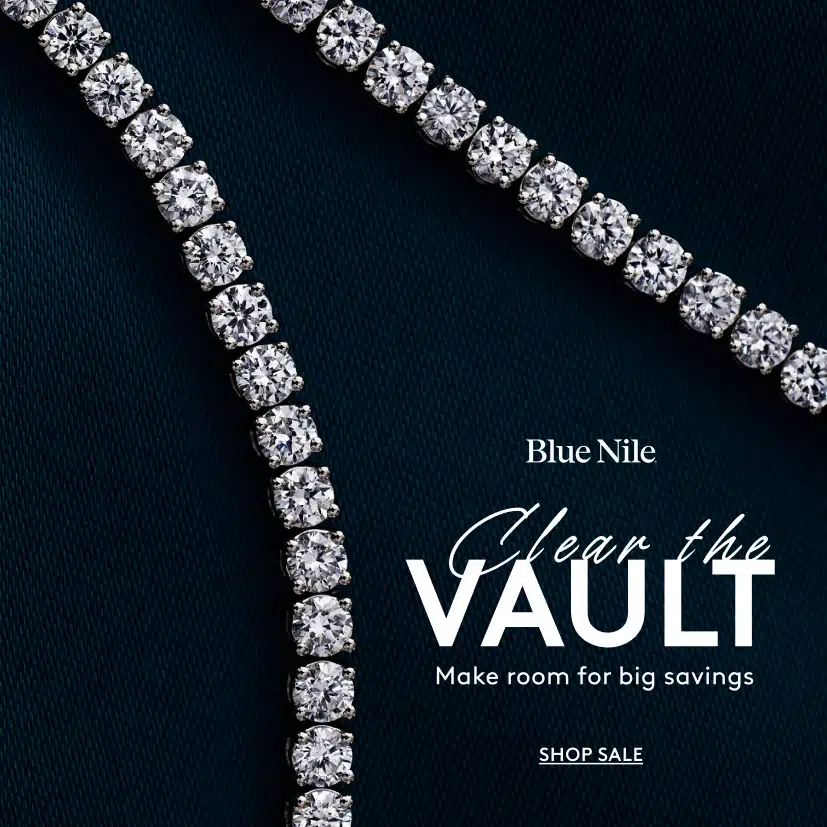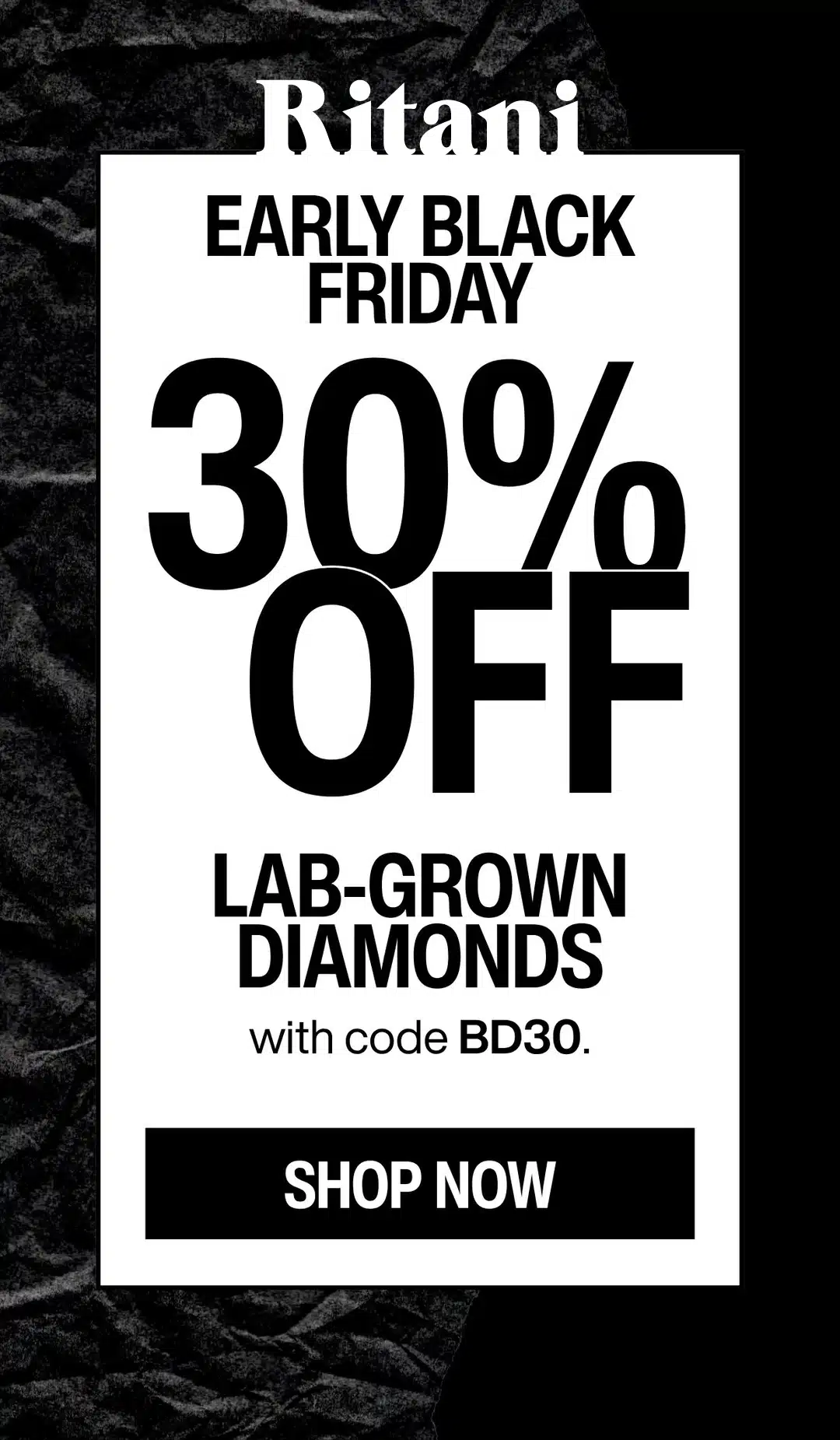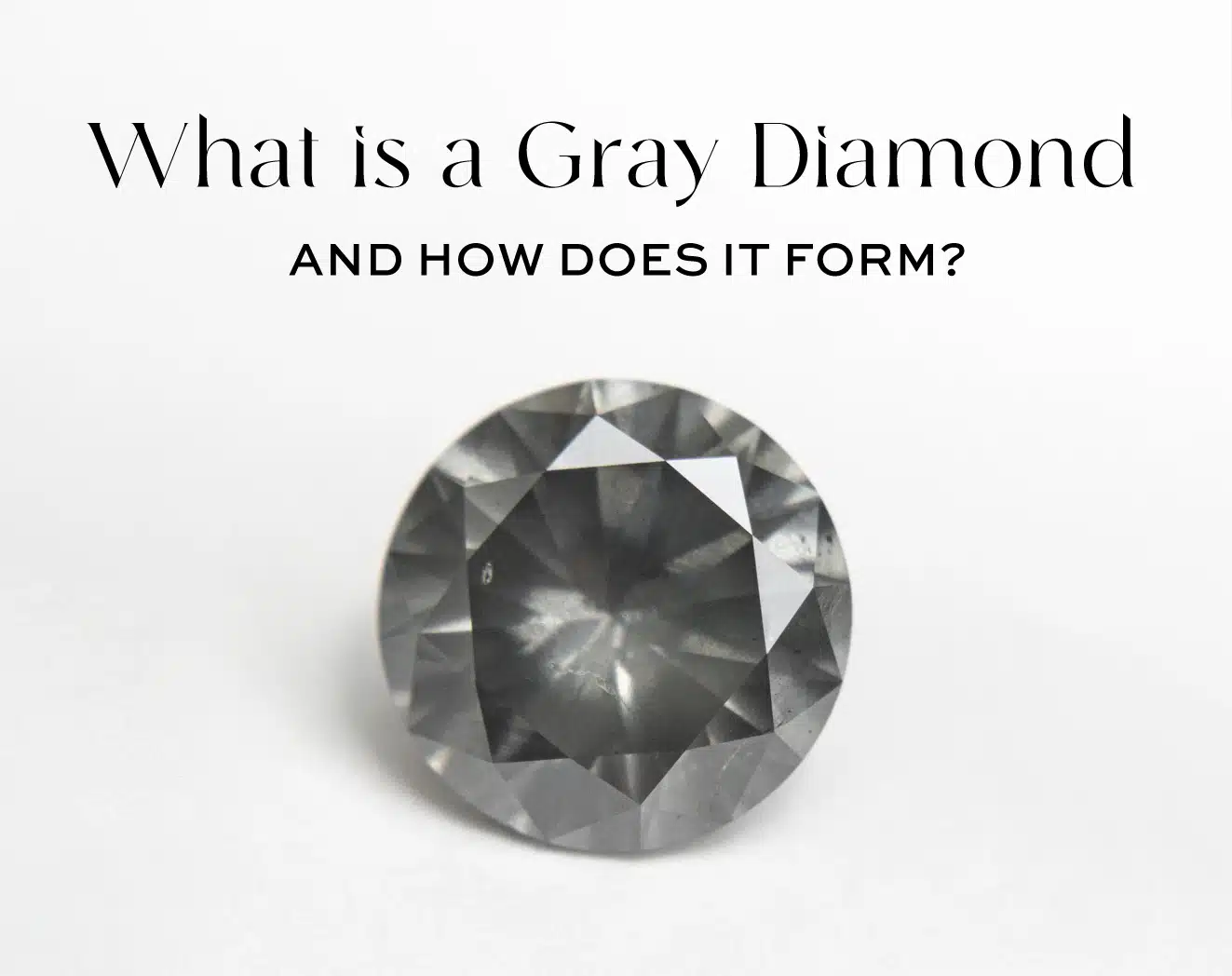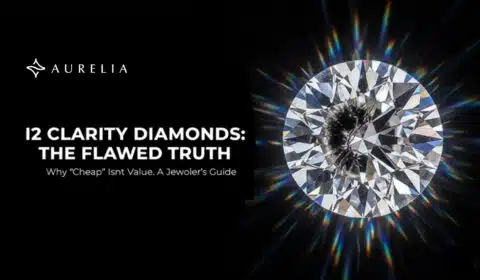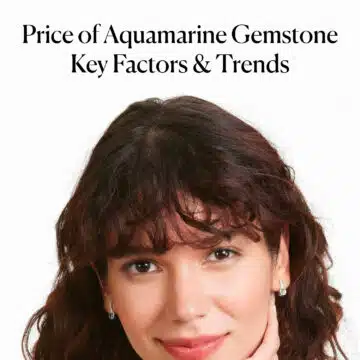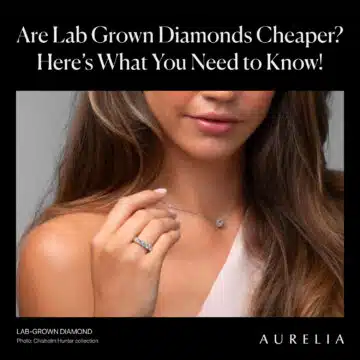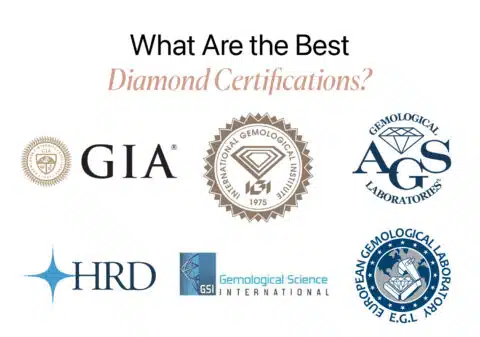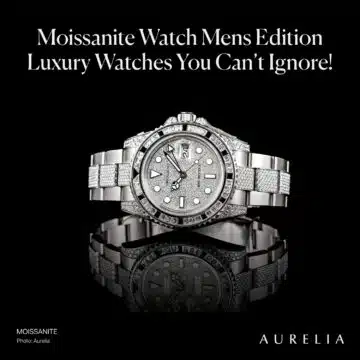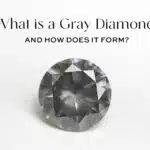A gray diamond is a rare, real natural diamond that gets its unique color from trace elements like hydrogen or boron, or from dense clouds of microscopic inclusions, resulting in a spectrum of hues from a light, silvery shimmer to a deep, stormy charcoal.
Let’s be honest, when most people picture a diamond, they think of that bright, blinding, colorless sparkle. It’s a classic for a reason. But I’m going to let you in on a secret: in the world of high fashion and for true jewelry connoisseurs, there’s a new king of cool, and it’s the gray diamond.
This isn’t a “dull” or “imperfect” stone. A gray diamond is moody, modern, mysterious, and undeniably chic. It’s the very definition of “quiet luxury”—a stone that whispers its elegance rather than shouts it.
Deal Alert: Elevate your design. Get up to 30% OFF engagement ring settings at Blue Nile !
One In A Lifetime Sale: “Clear The Vault” – Get up to 70% OFF on select jewelry at Blue Nile !
| Pro Tip: See every detail with 360° HD videos available at James Allen .
That’s why I’ve built this guide. This is the definitive, A-to-Z resource you’ve been searching for. As your expert guide, we are going to explore the fascinating science of how a diamond can be born gray. We’ll decode the critical difference between a “Fancy Gray” and a “Salt & Pepper” diamond.
I’ll walk you through a real-world price guide using dozens of examples so you can see the incredible value for yourself. And together, we will discover exactly why this once-overlooked gem is now a must-have for those in the know.
Diamond IQ Test: Natural or Lab-Grown?
Two identical diamonds: GIA Certified, 1.51ct, D Color, VVS1, Ideal Cut. One is natural ($16,530), the other is lab-grown ($2,390). Choose the diamond you like better and see if you can match it to its origin.
The Science: How is a Gray Diamond Formed?
The question is simple, but the answer is a fascinating story with three different main characters. Unlike a yellow diamond, which has one primary cause of color, a gray diamond is a geological mystery that can be solved in several ways.
As your “friend in the business,” I want you to understand all three, so you know the full story of the stone you’re looking at.
The Boron Connection: The Blue Diamond’s Cousin
This is the rarest and, to me, the most fascinating way a diamond becomes gray. It’s the exact same science that creates one of the most valuable gems on Earth.
The Expert Explanation: “One of the rarest ways a diamond becomes gray is the same way it becomes blue. Traces of the element boron get trapped in the diamond’s carbon structure during its formation. This creates what scientists call a Type IIb diamond.
While a higher concentration of boron results in a vibrant blue, a lower or different concentration can create a stunning, pure gray diamond hue. These Type IIb diamonds, like their famous Blue Diamond cousins, are exceptionally rare and even have a superpower: they can conduct electricity!”
Based on GIA research, only about 10% of all natural gray diamonds get their color this way, making them a true collector’s prize. Many of these rare specimens originate from the legendary Cullinan Diamond Mine in South Africa.
The Hydrogen Factor: The Most Common Cause
This is the usual suspect, the most frequent reason for a diamond’s beautiful, moody gray color.
Instead of boron, the impurity here is hydrogen. During its formation, a higher-than-usual concentration of hydrogen atoms can become integrated into the diamond’s crystal structure. Scientists are still studying the exact physics, but this infusion of hydrogen alters the way light passes through the gem, absorbing certain wavelengths and resulting in that signature silvery, steely, or diamond gray appearance.
My Expert Take: “This is the beautiful, classic gray. It’s not trying to be blue; it is proudly and uniquely gray. Many of the most beautiful and nuanced gray diamonds, especially those with incredible violetish undertones, came from the now-closed Argyle Mine, making them even more special today.”
A beautiful example of a stone likely colored by hydrogen is this GIA 1.02 Carat Fancy Gray-SI1 Radiant Cut Diamond from Blue Nile for $4,020. Its pure, steely color is exactly what connoisseurs look for. Understanding how these elements are graded is a fundamental part of gemology, which you can learn about in my Diamond Grading Chart (4 Cs) Guide.
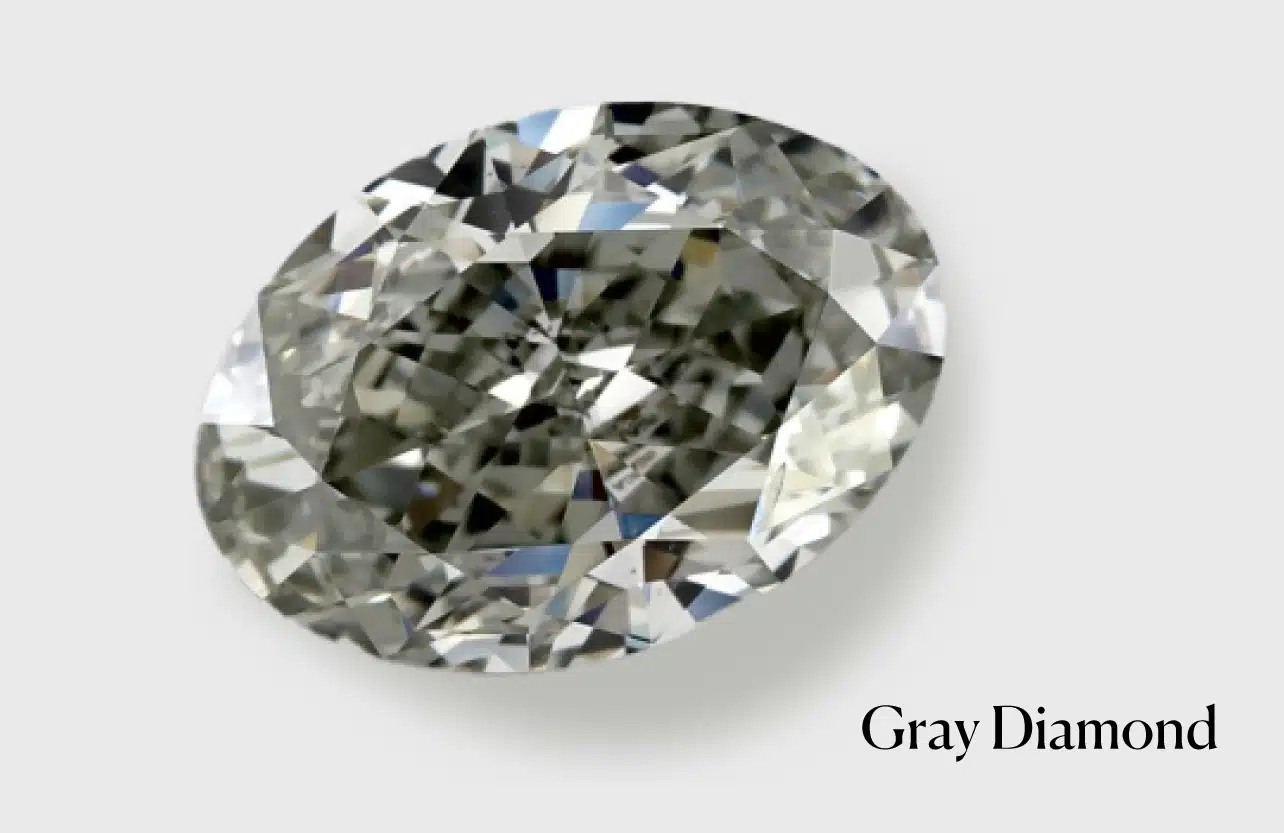
The Inclusion Story: Nature’s Perfect Imperfections
The third way a diamond becomes gray is perhaps the most poetic. It’s not an atomic impurity but a case of the diamond carrying a piece of its formation journey within it.
In these stones, the diamond gray color is caused by dense clouds of microscopic mineral inclusions. Think of it like this: if you have a perfectly clear glass of water, and you add one speck of black pepper, you see a flaw.
But what if you added millions of microscopic, perfectly distributed specks of pepper until the entire glass looked a uniform, beautiful gray?
That is what’s happening inside these diamonds.
- GIA scientists confirm that these clouds are often composed of graphite, the very same carbon as the diamond, just in a different form.
- To the naked eye, these micro-inclusions blend together perfectly, creating a solid, uniform gray color.
- When the inclusions are slightly larger and more distinct, the stone is no longer called a “Fancy Gray.” It earns the popular and artistic name “Salt and Pepper” diamond.
A great real-world example of this is the GIA 2.00 Carat Fancy Gray-I1 Round Cut Diamond from James Allen for a remarkable $2,560. The “I1” clarity grade is a direct clue that its beautiful color is a result of these dense inclusions.
While an I1 grade can be a red flag in a colorless stone, as I explain in my I1 Clarity Diamond Guide, here it is the very source of the diamond’s unique beauty. It’s a perfect example of a gem where you embrace the inclusions, a concept that completely flips the script on what makes the Best Diamond Clarity.
Decoding the Shades: “Fancy Gray” vs. “Salt & Pepper” Diamonds
Alright, this is one of the most important—and most confused—parts of the gray diamond conversation. You will see both “Fancy Gray” and “Salt and Pepper” used to describe these stones, but they are not the same thing.
As your guide, I need to make the distinction crystal clear. One is the choice for the classic connoisseur, and the other is for the modern artist. Knowing the difference is key to finding the stone that speaks to you.
Fancy Gray Diamonds: The Connoisseur’s Choice
This is the pinnacle. A Fancy Gray Diamond is the rarest and most valuable type of gray diamond. It’s a stone prized for its uniformity and its pure, unadulterated tone.
- What It Looks Like: A true fancy gray diamond has a smooth, even, and consistent diamond gray color throughout its entire body. When you look into it, you see a liquid, silvery, or deep steely appearance. The key here is transparency and uniformity.
- The Science: According to GIA, these are most often the diamonds colored by trace elements like boron or hydrogen, rather than dense clouds of inclusions. This allows the diamond to maintain a higher level of transparency and brilliance.
Mehedi’s Take: “This is a stone of pure, understated sophistication. It’s the ‘quiet luxury’ I was talking about. You’re not buying it for flashy patterns; you’re buying it for its perfect, moody, and serene tone. It is a very intentional and very chic choice.”
A spectacular real-world example is this GIA 3.02 Carat Fancy Gray-VS2 Pear Shaped Diamond from Blue Nile, priced at $39,790. The high VS2 clarity grade is a major clue that this is a true Fancy Gray, where you are paying a premium for its clean, uniform, and deeply beautiful color.
This is a level of quality that stands up to close inspection, a standard we discuss in my VVS1 Diamond Clarity Guide.
“Salt & Pepper” Diamonds: The Artistic Expression
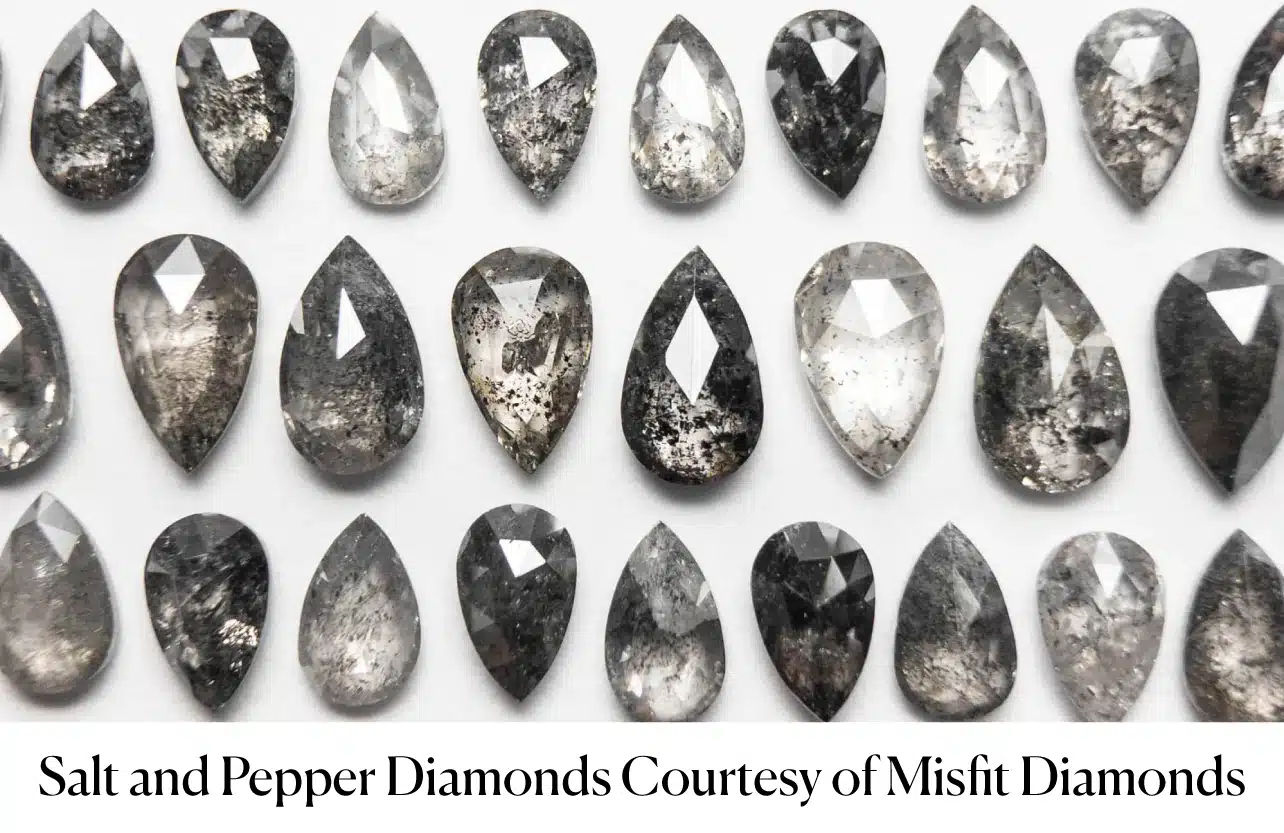
Now we enter a world of incredible personality and creativity. A Salt and Pepper Diamond is a gray diamond that gets its color from visible inclusions.
- What It Looks Like: These stones are defined by their visible black and white inclusions—the “pepper” and “salt.” The patterns can range from a light, delicate sprinkling to a dense, almost cosmic cloud. No two are ever alike.
- The Philosophy:“Let me be clear: these are not ‘flawed’ diamonds. They are canvases. The inclusions are not something to be avoided; they are the very feature you are celebrating. You are buying a unique, speckled, celestial pattern. Each one is a one-of-a-kind piece of natural art, a tiny, wearable galaxy.”
Mehedi’s Take: I love salt and pepper diamonds. They are for the individual who sees beauty in imperfection, who wants a stone with a story and a unique personality. They have a raw, earthy, and organic vibe that is incredibly fashionable right now. They are also significantly more affordable, making them a fantastic choice for a unique and stylish gray diamond engagement ring.
An excellent example is this GIA 4.53 Carat Round Diamond from James Allen for just $10,950. The “I1” clarity grade tells us its color is a direct result of heavy inclusions, making it a classic and beautiful “salt and pepper” stone at an incredible value.
This is a fascinating contrast to my guide where I warn you Are I2 Diamonds Worth Buying?, because here, the inclusions are the main event.
“Galaxy Diamonds”: The Rarest of the Artistic
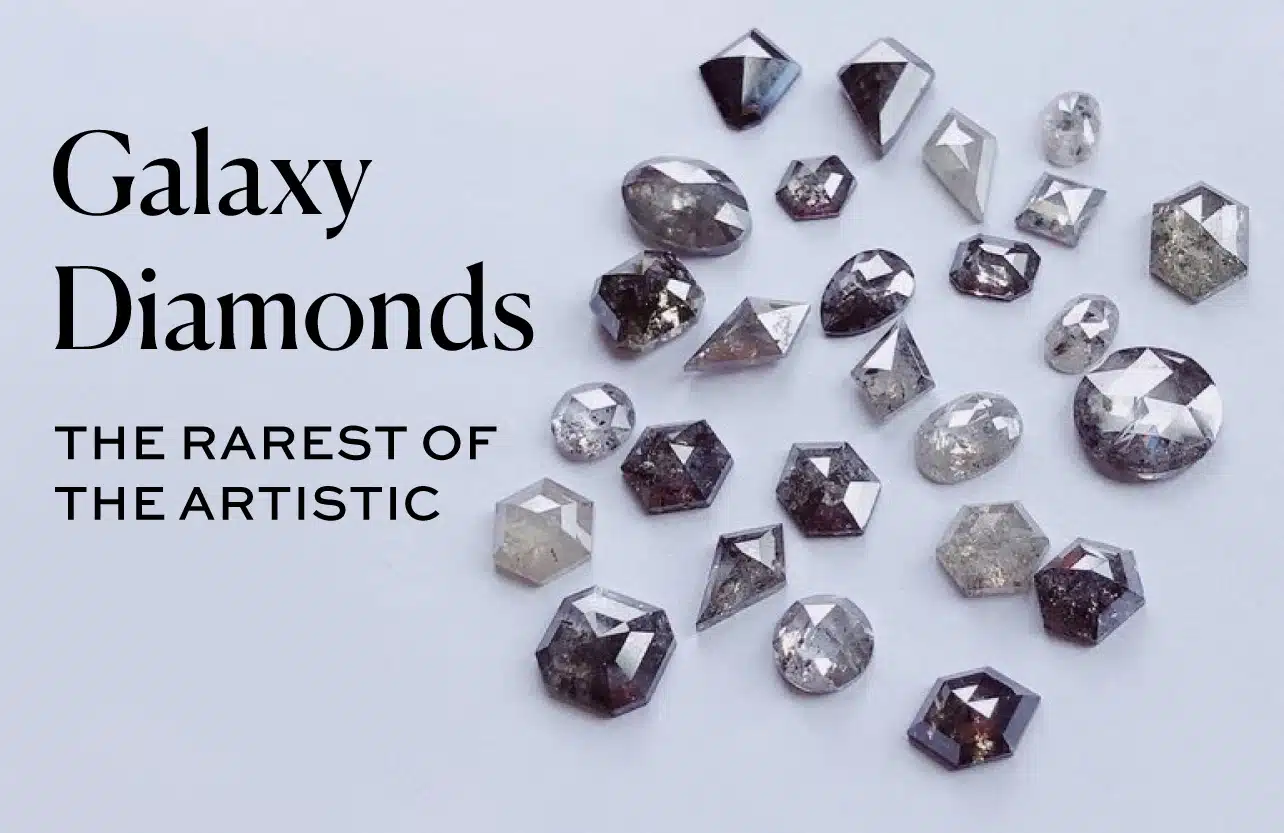
Within the world of salt and pepper stones, there is a top-tier category known as the “Galaxy Diamond.” This isn’t an official term, but a trade name used to describe the most coveted of all salt and pepper diamonds.
A galaxy diamond is a salt and pepper stone that has a very dark gray or nearly black body, with a dense and mesmerizing field of tiny, reflective inclusions that truly looks like a starry night sky. They are the rarest and most dramatic of all the “artistic” included diamonds.
Finding a true galaxy diamond is a treasure hunt, and they command a premium for their incredible, otherworldly appearance, a universe away from the simple elegance of other colored diamonds like the Brown Diamond.
Gray’s Family Tree: A GIA Deep Dive into the Blue-Gray-Violet Spectrum
Alright, now I’m going to take you behind the curtain and share a secret that most jewelers don’t even know. When the top scientists at the GIA study fancy diamonds, they don’t just look at gray in isolation. They study it as part of a breathtaking family of colors: the blue-gray-violet spectrum.
The legendary GIA article “Natural-Color Blue, Gray, and Violet Diamonds: Allure of the Deep” is our bible on this topic, and I’m going to break down what it means for you as a buyer. This is the insider knowledge that turns you into a true connoisseur.
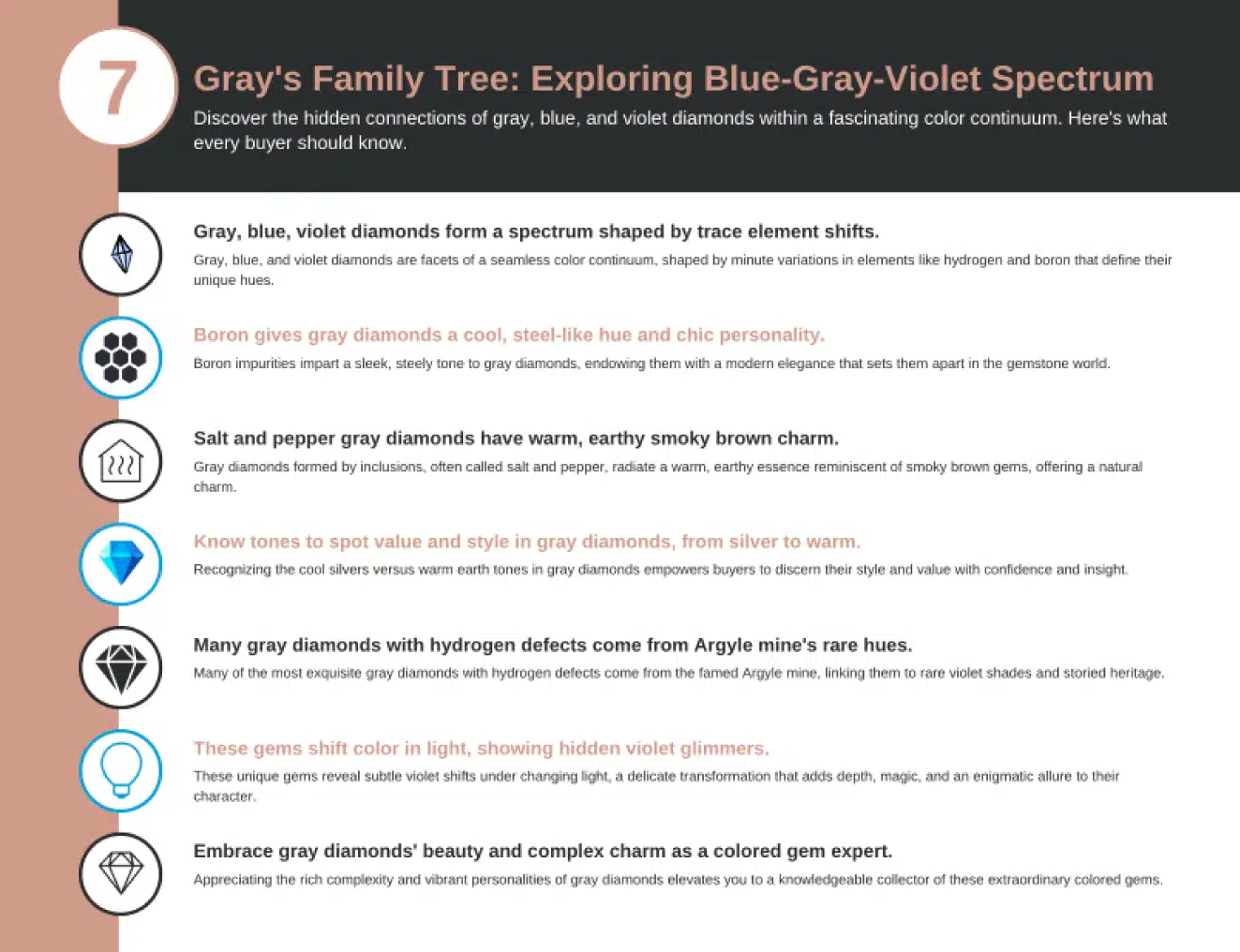
More Than a Color, a Continuum
Here’s the first big secret: geologically, gray, blue, and violet are not separate colors; they are points on a single continuum.
The GIA paper notes that “gray and violet diamonds… can coexist on a color continuum with blue diamonds.” What this means is that the causes of these three hues are deeply interconnected. A tiny, almost immeasurable shift in the concentration of hydrogen or boron can be the only difference between a GIA grader calling a stone a “Fancy Gray,” a “Fancy Blue,” or a “Fancy Violet” (a gem we explore in our guide to Purple Diamonds).
And the data from GIA’s massive study of over 15,000 of these gems proves it. Unmodified gray diamonds were the second most common color in this family at 33.1%, almost as prevalent as unmodified blues (37.8%). This proves that gray isn’t just a minor anomaly; it is a major, significant, and beautiful category of fancy colored diamond.
The Tale of Two Tones: A GIA Secret to Spotting Value
Now for the part that can make you a brilliant shopper. The GIA paper reveals a secret to understanding the “vibe” or “personality” of a gray diamond before you even see it. It’s a clue hidden right there in the science.
As the GIA paper explains, “many gray diamonds due to boron impurities will have a bluish (or cool) appearance.” This means that a gray diamond colored by boron (a Type IIb diamond) will naturally look like a piece of steel, a stormy sky, or a silver coin. It has a cool, chic, and very modern feel.
- A Perfect Example: This stunning GIA 1.01 Carat Fancy Gray-SI1 Oval Cut Diamond from Blue Nile, priced at $3,600, has that distinct, cool, silvery luster that is the hallmark of a boron-based gray.
Again citing GIA’s findings, “Many of the diamonds that derive their color from inclusions also… impart a yellowish (or warm) appearance.” This means that an inclusion-based gray—what we call a “salt and pepper” diamond—will have a warmer, earthier, more organic feel.
This makes it a close cousin to the beautiful gems we explore in our Brown Diamond Guide. It’s less “steely” and more “smoky.”
A Hint of Magic: The Argyle Connection and a Secret Color Shift
This is the final piece of expert-level knowledge from the GIA that connects the gray diamond to some of the most legendary stories in the gem world.
The GIA paper confirms a critical fact: the hydrogen-defect diamonds—which produce many of the most beautiful and nuanced gray and violet hues—are “almost exclusively from the Argyle mine.” This means that if you see a beautiful gray diamond with a distinct violetish secondary hue, there’s a very good chance it is a lost treasure from the now-closed, legendary Argyle Mine, home of the world’s most famous pinks and reds. That connection gives it a priceless historical significance.
Here is a fantastic “no-gap” detail that I love. The GIA scientists found that many of these hydrogen-rich gray diamonds…
“…can often appear violet under other light sources” like a warm, incandescent light bulb. – Natural-Color Blue, Gray, and Violet Diamonds: Allure of the Deep
This is an incredible, subtle color-shift effect that adds a layer of magic and mystery to the stone. It’s like having a little secret, a hidden personality that only reveals itself in certain moments. It’s not as dramatic as the effect you’d see in a true Chameleon Diamond, but it proves just how dynamic and complex these cool-toned gems truly are.
The family of fancy colored diamonds—from the fiery Orange Diamond and sunny Yellow Diamond to the rare Green and mythical Red, not to mention the bold Black Diamond—is full of these beautiful surprises.
The Gray Diamond Price Guide: A Surprising Affordability
We’ve talked about the science and the style. Now, let’s talk about the numbers, because this is where the story of the gray diamond gets truly exciting. Given their genuine rarity, most people assume they carry a price tag similar to other fancy colors. The reality is a wonderful surprise. For the savvy buyer, gray diamonds offer one of the most incredible value propositions in all of jewelry.
The Natural Gray Diamond Market: The Attainable Luxury
While a natural gray diamond is a rare gem, its market is significantly more accessible than that of its more flamboyant cousins like the Blue Diamond or the Pink Diamond. This creates a paradise for the buyer who wants a unique, large, natural diamond without the astronomical price tag.
Let me show you what your money can actually buy, using real-world examples from the top online retailers. This is where the value becomes undeniable.
The 1-Carat Sweet Spot
This is where the value is simply mind-blowing. You can acquire a beautiful, GIA-certified, one-carat natural fancy diamond for a price that is often less than a comparable colorless stone.
Consider these stunning examples:
- Look at this stunning GIA 1.01 Carat Fancy Gray-SI1 Oval Cut Diamond from Blue Nile. It’s priced at just $3,600.
- Or this gorgeous GIA 1.02 Carat Fancy Gray-SI1 Radiant Cut Diamond at James Allen for $4,020.
- Or this gorgeous GIA 1.02 Carat Pear Diamond at James Allen for $3,140.
A certified, 1-carat natural fancy diamond for this price is an incredible find and a testament to their value. For a fascinating contrast on value, check out my guide on How Much to Spend on a Wedding Ring, where a budget like this would typically limit you to much smaller colorless stones.
Deal Alert: Elevate your design. Get up to 30% OFF engagement ring settings at Blue Nile !
One In A Lifetime Sale: “Clear The Vault” – Get up to 70% OFF on select jewelry at Blue Nile !
| Pro Tip: See every detail with 360° HD videos available at James Allen .
Going Big Without Breaking the Bank
This is where gray diamonds truly shine. If you dream of a large, head-turning stone, this is your opportunity.“Want a head-turning stone over 3 carats? Check out this massive GIA 3.07 Carat Fancy Gray-SI2 Cushion Modified Cut Diamond from Blue Nile, priced at only $16,690. A 3-carat natural fancy diamond for this price is almost unheard of in any other color category.”
The Upper Echelon
As clarity and carat weight increase, so does the price, but it remains within a realm of attainable luxury.“This beautiful GIA 2.53 Carat Fancy Greenish-SI1 Oval Shaped Diamond at James Allen commands a price of $30,770. While a significant investment, this shows the premium a high VS clarity grade can bring. To understand that jump, a great next read is my guide on VS1 vs VS2 Clarity.”
The Lab-Grown Question: An Elusive Option
Now, what about lab-grown gray diamonds? This is where the story takes an interesting turn.
Mehedi’s Honest Answer: “As of today, lab-grown gray diamonds are not common in the market. Unlike blues, pinks, or yellows, the specific and complex conditions required to create a beautiful, stable gray diamond (whether with hydrogen, boron, or inclusions) are difficult to replicate consistently in a lab environment.
If you do find one, it would likely offer an incredible value, but the selection is currently extremely limited compared to natural stones.”This makes the natural gray diamond ring one of the few fancy colors where the natural option is still the primary, and most accessible, choice.
The technology is always evolving, and you can learn about the different methods in my deep-dive on the Types of Lab-Grown Diamonds.
Carat-by-Carat Price Table: Natural Fancy Gray Diamonds
| Carat Weight | Approximate Price Range (Good Quality) | Mehedi’s Expert Notes |
| 1.00 Carat | $3,000 – $6,000+ | The ultimate sweet spot for a unique gray engagement ring. |
| 2.00 Carat | $6,000 – $15,000+ | A significant, statement-making size with incredible presence. |
| 3.00+ Carat | $15,000 – $40,000+ | True connoisseur territory, offering massive value for a natural fancy. |
A Buyer’s Guide to the Perfect Gray Diamond Ring
You’re inspired by the cool, sophisticated vibe of the gray diamond, and you’re ready to explore buying one. Fantastic. This is where my job as your “friend in the business” really begins. The rules for buying a gray diamond engagement ring are different from any other gem. You need to think like a connoisseur, and I’m here to give you the insider’s playbook.
Reading the Color: Beyond Just “Gray”
The first and most important step is to understand the language of gray. It’s not one color; it’s a whole world of tones and moods. The GIA grades fancy gray diamonds on a scale of tone, from lightest to darkest: Faint, Light, Fancy Light, Fancy, and Fancy Dark.
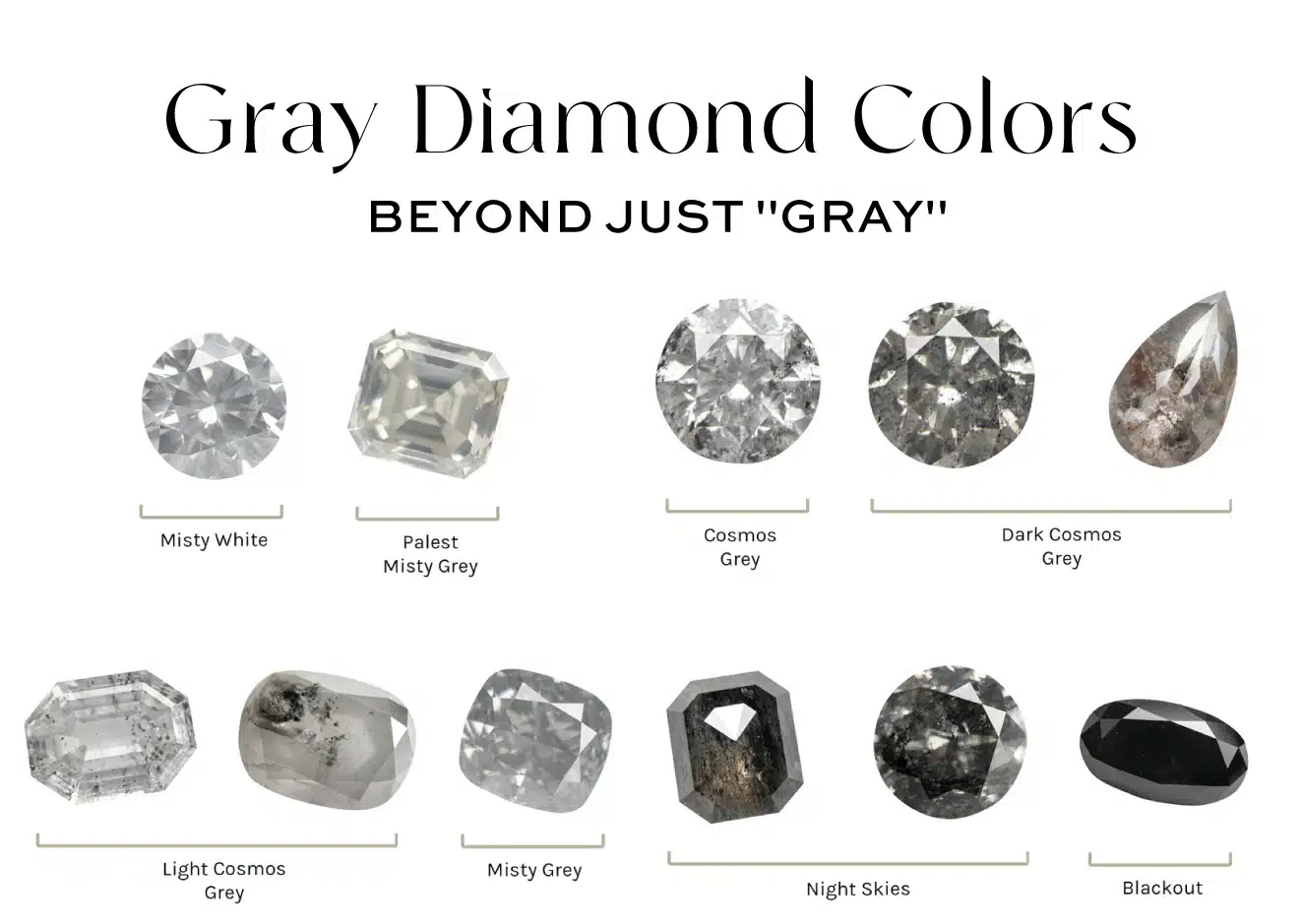
But the real secret, the detail that determines both the beauty and the price, is the secondary hue. A pure gray is rare, and most stones will have a color modifier.
The Value Enhancers
A secondary hue of bluish-gray or violetish-gray is a rare and highly prized combination. It creates a stunning, moody, stormy-sky effect that is incredibly beautiful and sophisticated. These are the most valuable and coveted of all gray diamonds.
The Neutral Hues
A greenish-gray is another beautiful and less common modifier. It creates a soft, earthy, sage or olive tone that is very unique and has a calming, organic feel. A great example of the complex beauty of modifiers is this GIA 2.53 Carat Fancy Greenish Yellow Gray-SI1 Oval Cut Diamond from Blue Nile, priced at $30,770, where three colors create a completely unique stone.
The Value Detractors
A brownish-gray is generally the least desirable secondary color. It can sometimes make the stone appear dull or “muddy,” killing some of its cool, silvery luster. As a result, these stones are typically more affordable.
Understanding these subtle differences is key to appreciating fancy gems, a topic we cover in our definitive Fancy Color Diamond Rarity Report.
James Allen: Our 5-Star Choice for Price and Selection
Check our comprehensive James Allen Review to learn more about their pricing and commitment.
The 4Cs, Reimagined for a Moody Gem
If you’ve been studying the 4Cs for white diamonds, you need to adjust your thinking. For a gray diamond, the priorities are completely different.
Color & Clarity (The Power Duo)
Color is absolutely #1. You are looking for a tone that you love. But the hidden secret to getting incredible value is Clarity. The moody, often opaque nature of a gray diamond is brilliant at hiding inclusions. This means a beautiful eye-clean SI1 or even SI2 clarity stone can look absolutely flawless to the naked eye for a fraction of the price of a VVS stone.
This GIA 1.02 Carat Fancy Gray-SI2 Pear Shaped Diamond from Blue Nile for $3,140 is a perfect example of a stunning, eye-clean stone at an amazing value. You can become an expert on this “sweet spot” by reading my SI1 Clarity Diamond Guide.
Cut
As with all fancy colors, the cutter’s goal is to enhance the color, not to maximize brilliance. They will choose a shape and facet pattern that brings out the richest, most even tone. This is a completely different philosophy from creating a super-ideal cut, which we explore in our guide to Hearts and Arrows Diamonds.
Setting Strategy: A Versatile Masterpiece
The setting you choose for a gray diamond necklace or ring will define its final personality. Gray’s neutral tone makes it incredibly versatile.
Platinum or White Gold
This is the classic, chic choice. It creates a cool, icy, monochrome look that is the very epitome of modern sophistication. The white metal blends seamlessly with the silvery tones of the diamond for a sleek and integrated feel.
Yellow Gold or Rose Gold
This is my personal favorite. The warmth of yellow or rose gold creates a stunning warm-and-cool contrast with the moody gray of the diamond. It’s a look that feels both vintage and incredibly modern at the same time, and it’s very popular with high-end designers.
Visualizing how these metals will play with your chosen stone is key. It’s why I’m a huge fan of services that allow you to experiment with different combinations, like the Blue Nile Creative Studio.
Where to Buy Gray Diamonds
For a stone with such subtle and nuanced beauty, you absolutely must buy from a vendor that offers two things: trustworthy certification and industry-leading imaging. For these reasons, my premier destinations for a gray diamond are James Allen and Blue Nile.
Read Our 5-Star Blue Nile Review
Check our comprehensive Blue Nile review to learn why we rated Blue Nile 5 stars for their exceptional quality and value.
Here’s why:
Massive Selection
They have an incredible, searchable inventory of GIA-certified gray diamonds in every shape and shade, from a GIA 1.00 Carat Fancy Gray Round Cut to a GIA 3.51 Carat Fancy Gray Pear Shape.
360° Videos Are Essential
A photo can’t capture the true personality of a gray diamond. Their high-definition 360° videos are absolutely non-negotiable. They allow you to assess the stone’s true tone, its luster, and check for any undesirable “muddiness.”
Knowing you can trust your online retailer and their technology is everything, a principle I explore in my comprehensive Blue Nile Unboxing Review.
Your Gray Diamond Questions, Answered
You’ve got questions about the diamond world’s most sophisticated secret, and you deserve clear, honest answers. Let’s tackle the most common—and most important—queries I hear from clients who are captivated by the magic of the gray diamond.
My Final Verdict: The Diamond of Quiet Confidence
So, we return to the central question: what is a gray diamond?
As you now know, it is a stone of beautiful complexity—a geological marvel colored by the very elements of our universe, a canvas for nature’s art in the form of “salt and pepper,” and the undisputed champion of “quiet luxury.” It is not a diamond that shouts; it is a diamond that confidently whispers.
The gray diamond’s true power lies in its incredible versatility and its unparalleled value. It is one of the only gems in the world that feels both timelessly elegant and modernly chic. It is a chameleon, looking just as perfect in a cool platinum setting as it does in warm, romantic rose gold.
And, most importantly, it is the single greatest value proposition in the entire natural fancy colored diamond market. It is proof that you can own a large, rare, and deeply personal natural diamond without needing a king’s ransom.
Ultimately, a gray diamond ring is a choice for the connoisseur, for the individual who values sophistication over sparkle, and for the person whose confidence is their most brilliant accessory.
Continue Your Research Journey
You are now an insider, equipped with the expert knowledge to appreciate one of the diamond world’s most sophisticated and best-kept secrets. The next exciting step is to take this foundation and continue building your expertise, turning you from a knowledgeable reader into a truly confident buyer. These hand-picked guides are the perfect next chapter in your education.
Deepen Your Knowledge of the Market
You understand the value of a gray diamond. Now, see how the top online retailers stack up in their offerings and overall experience.
- A Head-to-Head Battle of Innovators: My unfiltered, expert comparison in Ritani vs. James Allen: Who Comes Out on Top?.
- The New Guard vs. The Old Guard: An expert’s analysis in our Vrai vs. Blue Nile: Which is Right for You?.
- Understanding the Bedrock of a Reputable Retailer: My deep dive in Is Blue Nile a Reputable Company?.
Become a Connoisseur of Cuts & Clarity
You appreciate the nuances of “salt and pepper” diamonds. Now, become an expert in the other details that create a diamond’s unique personality.
- Explore a Unique Sparkle: My expert guide to the What is an Oval “Crushed Ice” Diamond Cut?.
- A Critical Detail of Vintage and Modern Stones: An expert explanation in Do Old Mine Cut Diamonds Have a Culet?.
- The Top Tiers of Diamond Purity: A full breakdown in Our VVS1 Diamond Meaning and Cost Guide.
Master the Practical Side of Buying
Let’s turn your passion into a smart, confident purchase with these essential, real-world guides from my years in the industry.
- A Critical Logistical Question: The practical, honest answer to Can You Buy an Engagement Ring on the Same Day?.
- Understanding the After-Market: A frank discussion about Selling Diamond Rings at a Pawn Shop: What to Expect.
- A Fun and Fascinating Niche Question: My answer to How Much Money is a Small Diamond with No Fingerprints Worth?.
James Allen is a top leader in online diamond sales, offering cutting-edge imaging technology that lets you inspect diamonds as if you were using a jeweler's loupe. With the largest exclusive selection of loose diamonds available online and excellent pricing, they also boast one of the finest collections of lab-created diamonds on the market. They currently run a 25% discount on selected lab-grown diamonds!
WHAT WE LOVE ABOUT THEM:
- 30-day no-questions-asked return policy, with a prepaid shipping label provided by James Allen.
- Lifetime warranty on all purchases.
- Free international shipping.
- Complimentary prong tightening, repolishing, rhodium plating, and cleaning every six months.
- Insurance appraisals included with purchases.
- One free resizing within 60 days of purchase.
- Free ring inscriptions available.
- Best-in-class high-quality imagery for every diamond in stock.
- 24/7 customer support.
- Premium, best-in-class packaging.
Blue Nile is one of the biggest and most recognized online jewelry retailers, offering an extensive and exclusive inventory. Their high-resolution images are improving and getting closer to the quality offered by James Allen, while their prices remain highly competitive. Right now, Blue Nile offers up to 30% savings on jewelry during a limited-time sale.
WHAT WE LOVE ABOUT THEM:
- 30-day no-questions-asked return policy, with a prepaid shipping label provided by Blue Nile.
- Lifetime warranty on all purchases.
- Free shipping on every order.
- Complimentary services every six months, including prong tightening, repolishing, rhodium plating, and cleaning.
- Insurance appraisal included with your purchase.
- One free resizing within the first year.
- High-quality images available for roughly half of their diamond selection.
- 24/7 customer service support.
- Full credit toward future upgrades, as long as the new item is at least double the value.
- Best-in-class order fulfillment process.


